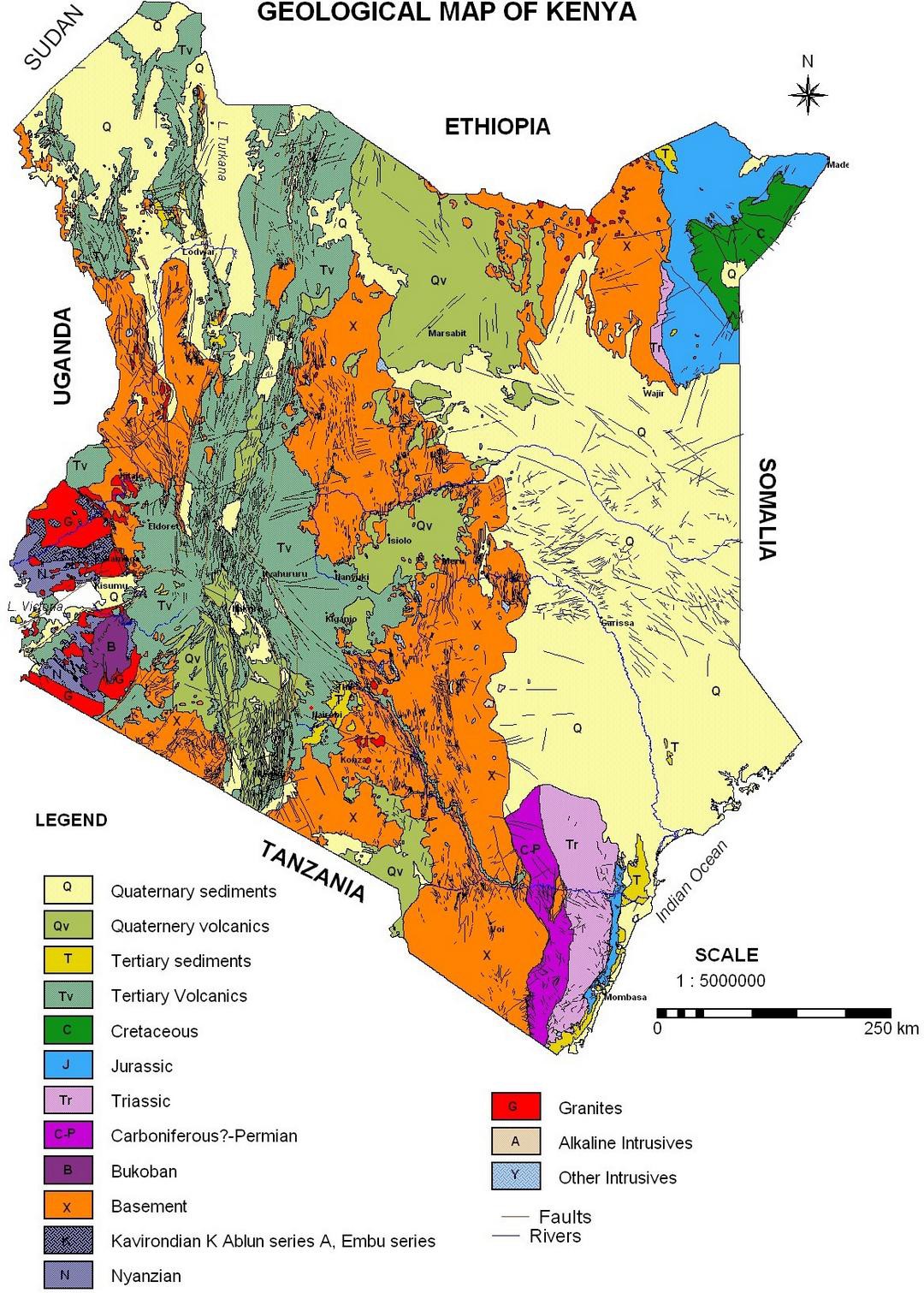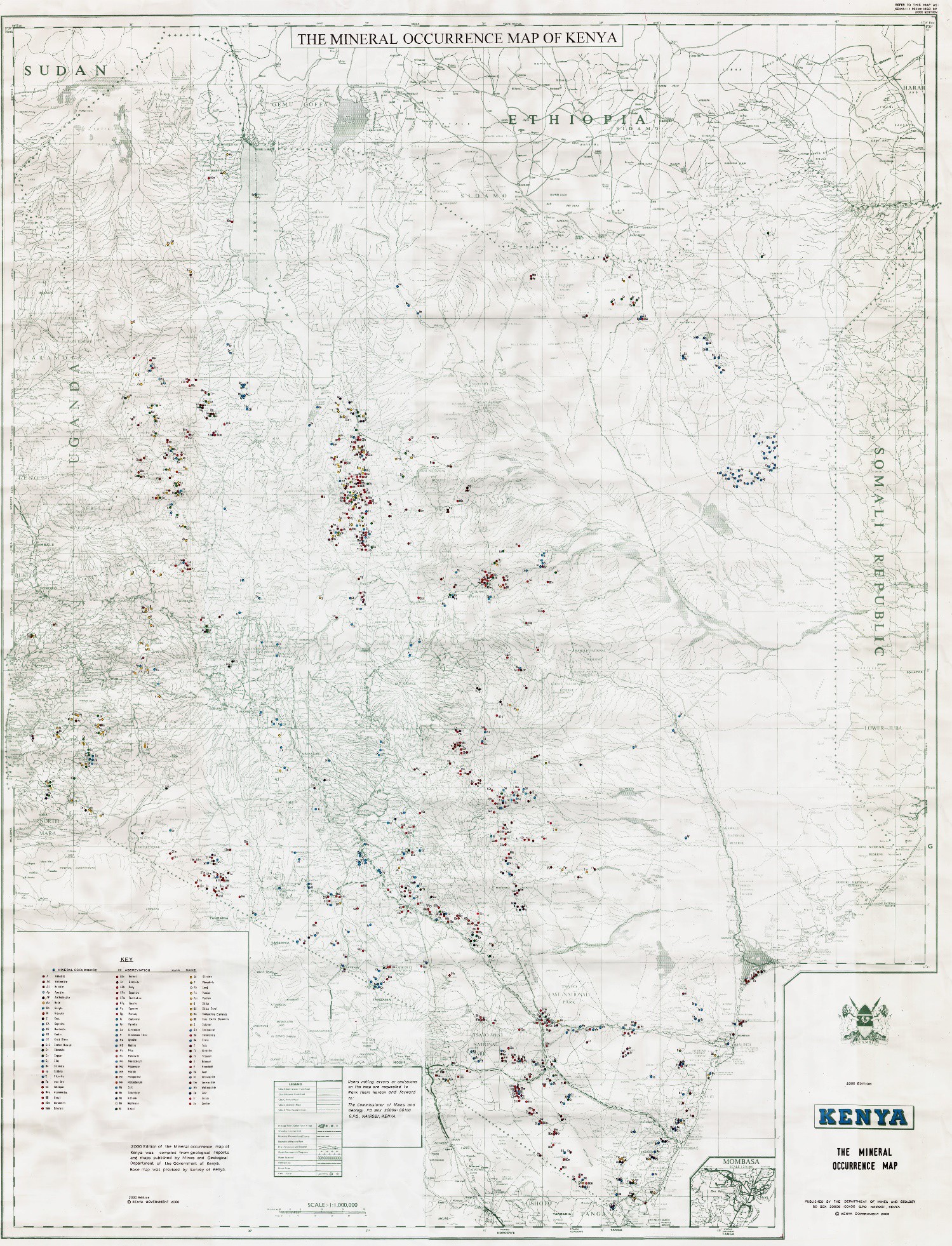A Summary of the Geology and Mineral Resource potential of Kenya
The geology of Kenya may generally be grouped into the following five major geological successions: Archean (Nyanzian and Kavirondian), Proterozoic (Mozambique Belt and Bukoban), Palaeozoic/Mesozoic sediments, Tertiary/Quaternary volcanics and Tertiary/Quaternary sediments.
Quaternary
Soils, alluvial beach sands, evaporites, fossil coral reefs and sandstones at the coast: alluvial and lacustrine sediments of the Rift Valley. There are also volcanic rocks of the Rift Valley from the younger volcanoes. They include the gypsum beds of Kajiado and Garissa counties and the Kanjira beds of Homabay county. The Quaternary formations cover large swathes of Kenya including the Coast, Eastern, North Eastern and Rift Valley regions.
Tertiary
These consist of the Coastal sediments, Late Miocene and Pliocene volcanics, terrestrial and lacustrine inland sediments. There are early Tertiary formations which are not represented at surface. Included in this group of rocks are the Alkaline Complexes (including carbonatites) of Mrima, Buru, Homa, Ruri and Rangwa hills in Kwale, Kericho and Homabay counties respectively.
Palaeozoic/Mesozoic
The Karroo formations of the Kenyan coastal hinterland, mainly the Permo-Triassic Duruma sandstone Group of the Karoo Super Group, also including the basal sedimentary formations of north-east Kenya. The break up of the Paleozoic Gondwana continent resulted in the formation of an intracratonic basin, filled with continental permo-Triassic clastics which make up the Duruma Sandstone Group.
Proterozoic
Kisii Group (Bukoban Super Group) consisting of volcanics with sediments. The volcanics mainly comprise of subaquatic and andesitic basalts, upper volcaniclastic beds of lapilli tuff and lahar conglomerates while sediments comprise lower detrital beds of siltite and local conglomerate, an arenitic formation of mature shallow water arenitic sediments with minor cinerite and chert as well as the Ikonge ignmbrite of rhyolitic igmbrite and minor andesite. The Kisii Group is an outlier covering most of Kisii and Nyamira counties in western Kenya that unconformably overlies the Archean Super Group.
The Mozambique Belt consist of quartzites, biotite/hornblende gneisses, schist, granitoid gneisses, amphibolites, and migmatites. These are rocks formed from magmatic underplating and a period of residence in the mid-lower crust followed by cooling between 830 and 520 million years ago. Almost all the constituent rocks of the Mozambique Belt attained at least upper amphibolite/granulite grade of metamorphism. According to current evidence it is suggested that low-grade ophiolitic/volcanosedimentary sequences are allochthonous and structurally emplaced over the higher-grade gneisses. Intrusives within the Mozambique Belt include mainly syntectonic granites. The Mozambique Belt rocks cover many counties in Coast, Eastern, Rift Valley and North Eastern regions of Kenya.
Archean
The Archean rocks of Kenya include the Kavirondian Super Group comprising mudstones, sandstones, conglomerates and granitic intrusions and the Nyanzian Super Group which comprises of shales, cherts, ironstones, pyroclastics, rhyolites, andesites and basalts. These rocks have been subjected to low-grade metamorphism of the greenschist level, leading to them being referred to as “greenstones”. The Nyanzian Group greenstone rocks differ from many greenstone belts by the relatively large amounts of andesite and rhyolite present. The overlying Kavirondian Super Group succession is composed chiefly of greywacke-argillite, tuff, arkose, and conglomerate.
Segregated geology
The Nyanzian Shield
The Nyanzian and Kavirondian Super Groups forming the Nyanza Craton are the oldest rocks in the country with ages over 3,100 million years. The Nyanzian Super Group is mainly composed of lavas and pyroclastics with minor sediments and Banded Iron Formations (BIF). The Kavirondian, which rests uncomfortably on the Nyanzian, consists of grits, sandstones, greywackes and conglomerates. Both the Nyanzian and Kavirondian Super Groups are isoclinally folded about axes that have an east-westerly trend. The Kavirondian, is only slightly younger than the Nyanzian but folding in the two Super Groups has similar orientation. Numerous granitic bosses and batholiths have intruded the Nyanzian and Kavirondian rocks. The Kavirondian intrusions were more but the pre-Kavirondian were also widespread and the two successions are discernible.
Mozambique Belt
The Mozambique Belt is a structural unit within which a wide variety of meta- sedimentary and meta-igneous rocks are found showing a broad concordance of structural style and metamorphic history. In most of these rocks, the degree of deformation is intense and is of high metamorphic grades. They were thus referred to earlier in literature as the basement system rocks, due to high degree of metamorphism and deformation.
Recent work on the Mozambique Belt has shown that the rocks can be sub-divided into groups of contrasting lithology, structure and composition of igneous rocks content. These groups are being studied in greater detail in order to come up with proper chronostratigraphic terminology.
Within the Mozambique Belt basic igneous complexes are found and range in size from bosses to small dykes. They occur both east and west of the Rift Valley. Some of the older basic intrusions have undergone deformation and metamorphism to give ortho- amphibolites and charnockitic gneisses.
Basic and granitic intrusions are known in the Mozambique Belt. The most characteristic feature of the Mozambique Belt is its structural trend which is more or less north-south in the entire belt.
Variations of the northerly trend are minor and when observed can be explained and are localised. The majority of Mozambique rocks have been placed in upper Precambrian (Proterozoic) Era.
Palaeozoic and Mesozoic Formations
Palaeozoic and Mesozoic formations in Kenya are found near the coast and in north- eastern Kenya. The earliest of these rocks are Permo-Carboniferous which are mostly sandstones and shales that form the Duruma series. This is equivalent to the Karroo Super Group in Southern Africa. The local formations are Taru, Maji-ya-Chumvi, Mariakani and the Mazeras. They extend for about 100 kilometres from Taru to Mazeras, west of Mombasa. The rocks dip very gently towards the ocean and are heavily faulted in places.
Mesozoic rocks occur in two separate areas, in the north-east part of Kenya and along the Coast belt. The stratigraphy and fossils in the two areas are very distinct and it is likely that the sedimentary basins in the two areas were connected. Revision mapping in the North Eastern region has come up with interesting lithological units that have revised lithological names.
Tertiary and Quaternary Volcanics
Volcanic rocks cover the central parts of the country from south to north, occurring in the floor of the Rift Valley and on the peneplains west and east of the valley. The oldest of the volcanics are of Lower Miocene age and comprise the eroded lavas and pyroclastic piles of South Nyanza. Late in Miocene times, Kapiti and Yatta phonolites were erupted and flowed to great lengths. Further eruptions accompanied by faulting persisted and also gave rise to the Rift Valley and the volcanic piles of Mounts Kenya, Elgon and Kilimanjaro.
Quaternary volcanism was mostly within the Rift Valley and has given rise to the craters and cinder cones that are found in the floor of the Rift Valley e.g. Longonot, Menengai and Suswa.
Tertiary and Quaternary Sediments
There are many sedimentary deposits of sediments of Tertiary and Quaternary ages in various parts of Kenya. They usually occur at the base of volcanic successions, intercalated with them or occurring in tectonic troughs. The repeated faulting of the Rift Valley floor and the numerous volcanic eruptions created many short-lived basins of internal drainage in which lacustrine and fluviatile sediments accumulated. Most of these sediments are unfossiliferous, but a few are of interest as they contain deposits that bear artefacts and interesting fossils that have been studied extensively.
The more important sediments of middle Pleistocene are the Olorgesaillie lakebeds (Rift Valley), a lacustrine series with much diatomite, mammalian fossils and artefacts. This is also comparable to the Kariandusi sediments near Gilgil (Rift Valley) and the Kanjira beds in the Kavirondo Gulf of Lake Victoria.

Mineral occurrences of Kenya
A wide range of minerals, both metallic and industrial, are known to occur in the country. These include barite, gypsum, gold, silver, lead, talc, titanium, salt, a variety of gemstones, (mainly ruby and several varieties of garnets) dimension stones, silica sand, heavy mineral sands, manganese, zinc, wollastonite, graphite, kaolin, copper, nickel, chromite, pyrite, various clays, rare earth elements and pyrochlore.
The Geological environments for the mineralization can be summarised as follows:
-
The Archean Nyanzian Craton area of Western Kenya where metallic mineralization of base and precious metals are known to occur: gold, copper and silver have been mined in the past. They are also potential for ferrous and no-ferrous metals. Kimberlitic bodies have also been reported.
-
The Proterozoic Mozambique Belt that is most extensive in middle parts of Kenya, north to South, in which minerals such as kyanite, corundum, graphite, wollastonite, marble, asbestos, fluorspar, magnesite, kaolin and a variety of gemstones are found together with minerals associated with basic and granitic rocks.
-
The sedimentary rocks of Palaeozoic to Quaternary are widespread. These rocks are sources and hosts of limestone, gypsum, clays, manganese, construction materials and hydrocarbons. Base metal mineralization, lead-zinc-barite and copper are known to occur in the sedimentary basins along the Coastal belt.
Heavy mineral sands also occur along the coastal ranges and recently deposits of about 3.2 billion tons of titanium bearing sands have been discovered and are being mined.
- The volcanic rocks associated with the Rift System host a variety of minerals and construction materials. The volcano-sedimentary accumulations have deposits of clays, evaporites, trona (soda ash), diatomite, natural carbon dioxide, kunkar and gypsum. Gem quality rubies have recently been discovered.
Carbonatites are known to be host of several minerals found in the Nyanzian shield area, around Lake Victoria shores and in the southern part of the coastal sedimentary basin. Mrima, one of the carbonatites known for potential of niobium and rare earth elements (REE) is found in the coastal basin, south of Mombasa. Other sources include Buru, Homa, Ruri and Rangwa hills in western Kenya.
